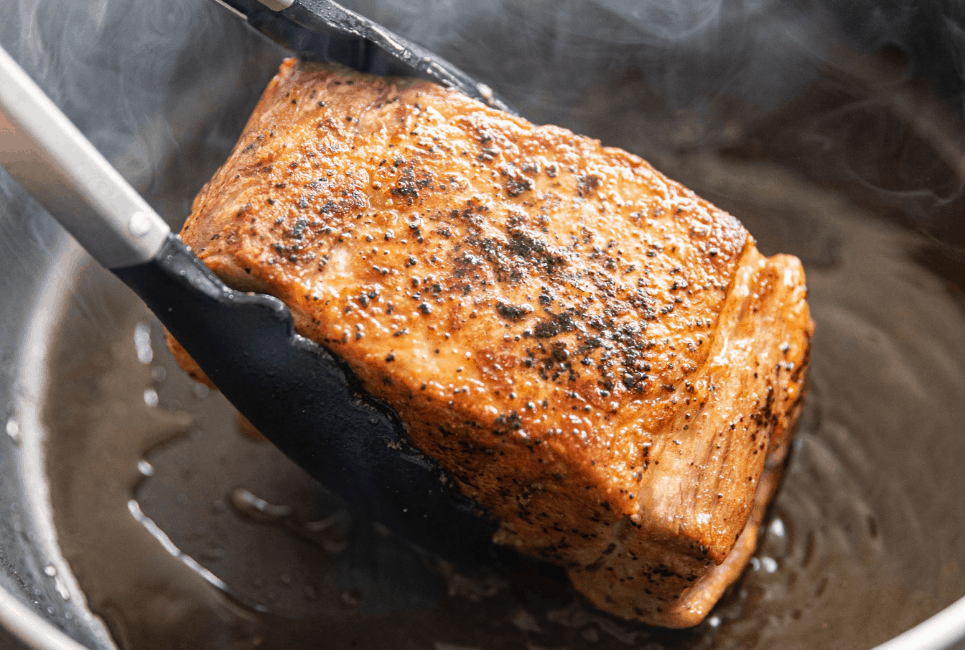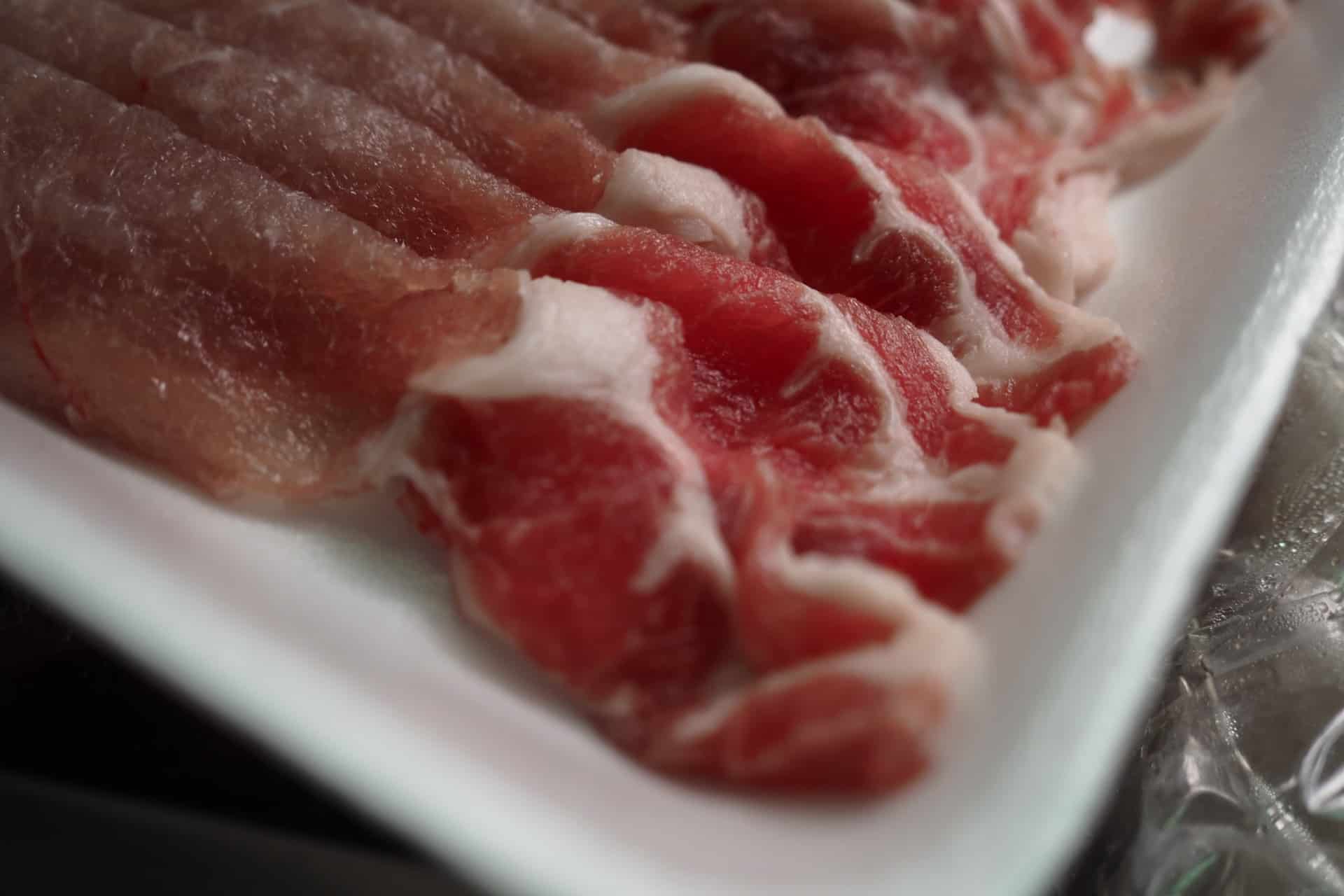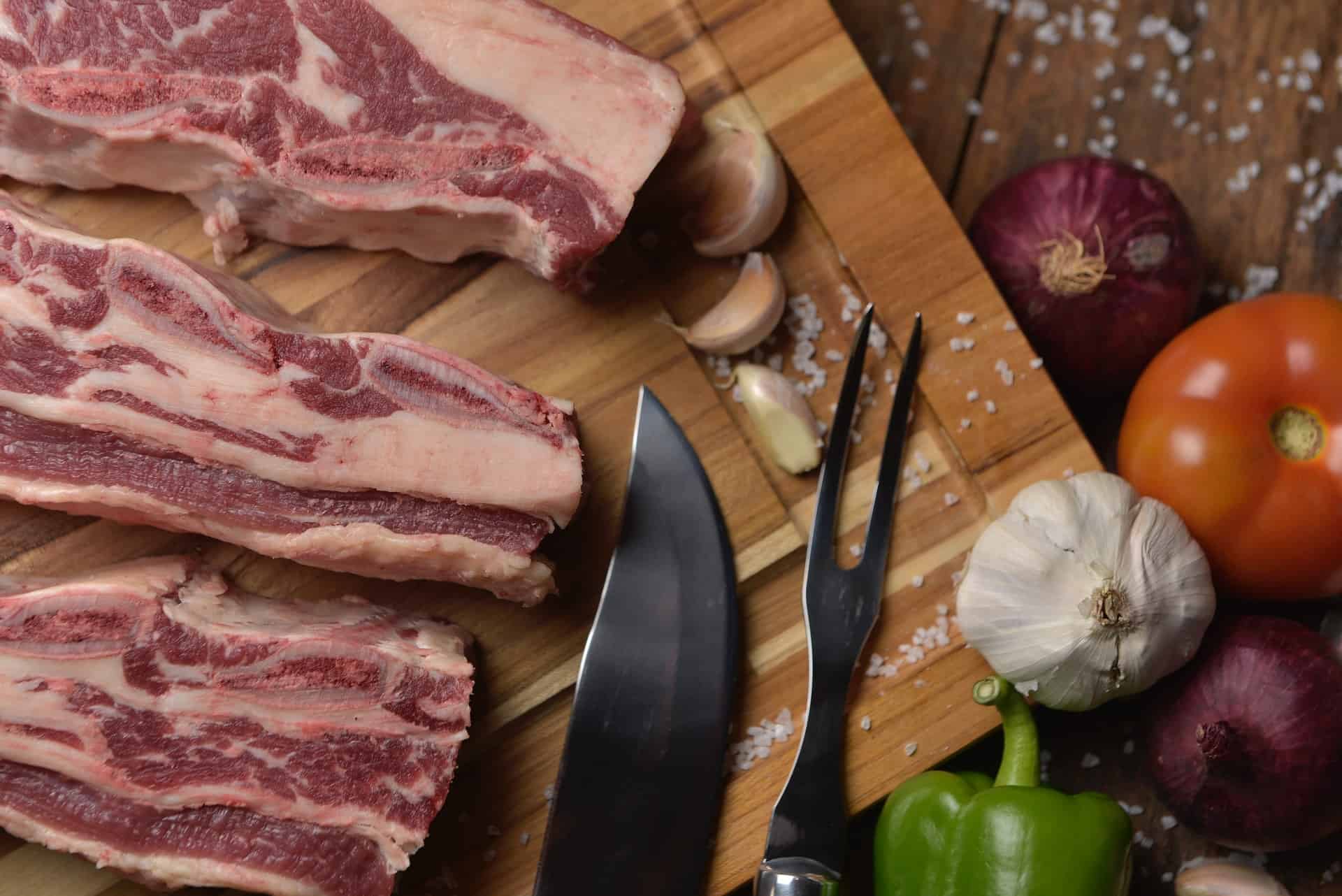- Salt Pork vs Pork Belly: Which Is Better? - September 1, 2021
- Ham vs Pork Explained: The Ultimate Guide - August 28, 2021
- Russian Sausage Guide and History: Best Types and Recipes - August 25, 2021
Pork meat is beloved and eaten all over the world save for certain areas, and has a presence in most cultural and nationally famous cuisines and dishes. Different places and countries typically have their own way of cutting pork, but some cuts are common almost everywhere.
Among these cuts is pork belly and it’s derivative salt pork, and while many think they’re the same thing, there are some differences.
Main Differences Between Salt Pork and Pork Belly
- Salt Pork is a cured meat and fat made out of pork belly, whereas pork belly is a cut of pork taken from a pig’s side.
- While salt pork may resemble an uncut slab of bacon, whereas pork belly looks like cubical bits of meat with a rubbery skin layer, an off white layer of fat, and a light pink layer of meat. Pork belly can be used in many shapes and forms
- Pork belly is used to add richness and flavor to ground pork and sausages, whereas salt pork is salted and cured pork that usually tastes like bacon, though bacon is smokier and leaner.
- The rendered fat from cooking salt pork is usually used for cooking, whereas no such use for pork belly is too popular.
- Salt pork isn’t only made from pork belly, but also from other cuts.
- Salt pork may be an ingredient in multiple dishes and as a substitute for bacon, whereas pork belly dishes are common in many restaurants as main courses.
Pork Belly – What You Need to Know
Where Does Pork Belly Come From?
Pork Belly is a cut of pork taken from the sides of a pig’s body. It’s a cheap and fatty cut, and comes with the skin on more often than not.
Different Kinds of Pork Belly
Pork belly is eaten in countless forms, including bacon, salt pork, and pancetta. Let’s get into how all these types are made and eaten:
- Bacon: Bacon is typically made from pork belly by curing it and smoking the meat. Once the bacon is ready, it’s used as a very popular breakfast food all over America.
- Salt Pork: Salt Pork is very much like Bacon, the only difference being that it’s cured and salted, but not smoked. When uncut, it looks a lot like Bacon and may be used as a bacon substitute in many dishes and meals.
- Pancetta: This is another cured meat made from pork belly, but Pancetta is Italian in origin. It takes about three weeks to cure and can be eaten both cooked and uncooked, and is often used as an ingredient in soups and pastas, or served cold in sandwiches.

What Does Pork Belly Taste Like?
Pork belly has a rich, meaty flavor that can be enhanced and improved in the many dishes it’s used in. From the crispy, hearty richness of cooked pork belly, with its crispy skin, velvety layer of fat, and that perfect meat, to the rich velvety texture of Pancetta and the rich symphony of textures that was fried pork belly, this is one pork cut that possesses as much range as anything else.
Pork belly is usually served as a savory item on the menu, but sometimes you’ll taste a little bit of brown sugar or sweet sauces on it too. The best example of this would be maple bacon and bacon that’s cooked with brown sugar. You can also add sweet BBQ sauce to sandwiches that have Pancetta or Salt pork in them.
Pork Belly Dishes and Pairing Options
Pork belly is savory and rich, which means the best pairing options would be light and refreshing.
- Apple Salad: Apple salad, or any variation of a Russian salad, would go great with the rich and meaty flavor of pork belly. Just make sure to balance that richness with light fruits, some cabbage, and the right amount of sweet Russian salad dressing!
- Mashed Potatoes: Mashed potatoes are a great side dish to almost any meaty dish, and pork belly is no exception. Whether it’s slow-roasted pork belly or something a bit juicier like a pork belly pie or stew, mashed potatoes can balance it all out perfectly. You can also add something extra to the mashed potatoes (like mustard) for an extra kick to your meal.
- Lemon and Cabbages: The juicy, crispy, and citrusy flavors of the lemon and cabbage can be the perfect buffer for the richness of pork belly. You can either drizzle the lemon on the pork belly directly or try to incorporate the flavor in the cooking itself while you serve cabbages on the side. An ideal way to serve cabbage with anything is in coleslaw.
- BBQ Pork Belly and Pineapples: Haters are gonna hate, but after pineapples on pizza, I propose we bring out BBQ pork belly and pineapple skewers, or BBQ pork belly with pineapple sauce. The sweet and tangy flavor of pineapples gives depth and dimension to the pork belly and would be a refreshing variation from the salads and cold side dishes typically served with pork belly.
- Pork Belly in a Bun: Have pork belly leftover from the dinner last night? How about you make some makeshift burgers out of them for breakfast? Gather up all the pork belly and place it in the burger buns or sliders, put in some sauces, like BBQ sauce, mustard, mayonnaise, and any others you like along with any veggies you want. Caramelized onions taste great in burgers if you don’t have any cabbages laying around.
- Mac n Cheese with BBQ Pork Belly: Cheese is yet another thing that can be paired flawlessly with meat – in fact, that’s the whole point of charcuterie boards – and serving mac n cheese with your pork belly takes your dinner to a whole new level. This is a pairing meant for the quieter, more informal nights.
What Does Pork Belly Look Like?
Pork belly with skin, in its cubed form, looks like small cubes of meat that are a rubbery pinkish grey on one end with an off-white fatty layer, and a final, pink layer of meat that’s commonly marbled with more fat.
When cooked, the layer of skin crisps up perfectly to a golden brown color, and the meat darkens a bit. The trick to achieving perfect color and texture for a cooked pork belly is to keep the heat low.
Where Can You Find Pork Belly?
You can find pork belly in a lot of restaurant dishes, and you can get your hands on uncooked pork belly at any butcher’s shop or a grocery store with a butcher’s corner.
In its other forms, pork belly is insanely easy to find. Bacon is sold even at gas stations, pancetta is a common part of Italian cuisine, pasta, salads, and sandwiches, while salt pork is as easy to make as it is to find in a grocery store.

Salt Pork – All You Need to Know
How to Make Salt Pork?
Salt Pork is simply salted pork belly, and though it’s confused with bacon often, salt pork isn’t smoked or cooked. It’s a cured meat that’s made by rubbing salts, spices, and sometimes even brown sugar on pork belly. This slab of meat is then kept in the refrigerator for up to two weeks – the longer you let it stay there, the saltier it becomes.
The salt also draws out any moisture from the pork belly, which makes the end result dry but flavorful.
Most people who want to make salt pork calculate the amount of salt needed for a certain amount of pork belly by weight, which is why you’re likely to need a weight machine if you want to make some at home.
What Does Salt Pork Look Like?
Salt pork looks like an uncut slab of bacon, but when you bite into it you realize that it’s missing that smokey flavor. That’s because unlike bacon salt pork isn’t smoked.
What Does Salt Pork Taste Like?
Salt pork is salty and savory, as the name implies, and uses a mix of salt, spices, and often brown sugar to give the meat some intense flavor. Making salt pork at home means you’re able to control how salty you need it to be – if you want it lightly salted, you don’t have to leave the salted meat lying around for too long, but if you need it tasting a bit stronger, you can leave it in the fridge for up to two weeks.

Salt Pork Dishes and Pairing Options
Salt pork is almost like bacon, but it lacks the smokiness and is heavy on the salt, as is apparent with the name. If you want to eat and cook with salt pork, you need to be careful about how much you consume, especially if you’re prone to experiencing high blood pressure or are on the older side.
Most salt pork recipes pair it with simple, fresh options that counter the saltiness of the salted pork as well as it’s meatiness, just like all the pairing options for pork belly. They are, after all, almost the same thing.
That said, salt pork doesn’t have nearly as much range as pork belly does, and it doesn’t have the complicated flavor profile and substance to it that would make it the center of attention in a dish or the main course. While other things are usually served with pork belly as side dishes, salt pork is added to other recipes as a side dish or an ingredient.
- Cooking with Salt Pork: cooking with salt pork leaves you with rendered fat from the salt pork in the pan along with crispy bits of salt pork (depending on how the pork is cut). The rendered fat is a delicious option to cook anything from fish to baked beans in it, and that’s what many people do. Cooking with salt pork or using the rendered fat for cooking other things will add great flavor and depth to your meal – a kind that you won’t be able to find while using vegetable oil.
- As a Substitute to Bacon: Bacon is one of the most well-loved forms of pork belly, but if you’re not a fan of the smoky flavor, try replacing bacon with fried or grilled salt pork in most of your meals. You can serve it with eggs and pancakes, use it in sandwiches, and do pretty much anything with it that you would with bacon.
- Salt Pork in Stews: Salt pork adds a crisp and some dimension to stews and soups. If you want to enhance an existing recipe by adding salt pork to it, make sure you decrease the amount of salt you add. You can either serve the stew with salt pork on the side, and even make it crispy by frying it, or you can put it in the stew itself as meaty chunks that add texture to it.
- In Seafood Chowder: It might sound like a unique combination, but seafood chowder will take on a life of its own once you add salt pork to it.
- Fried Salt Pork with Vegetables: Any number of vegetables will taste great with salt pork, but my personal favorites will be leafy greens like spinach or cabbage. Two very different flavor profiles, but the taste will be equally great. You can pair fried salt pork with boiled or fried spinach cooked with onions and spices, or you can pair it with fresh cabbage and some delicious sauces of your choice.
- In Salads: If you’re making a bowl of salad at home and miss a meaty addition to it, maybe salt pork would be the perfect option. Salt pork can help you add that saltiness and rich taste and flavor to your salad that most others are missing, but be careful with how much you add. Salt pork isn’t the healthiest food!
- Saute Vegetables With the Rendered Fat: As I mentioned before – when you cook salt pork in a pan, you’re left with rendered fat in there. This fat is perfect to saute vegetables with, and these vegetables will go great with the salt pork you just cooked.
Where Can You Find Salt Pork?
You can make salt pork pretty easily at home or you can find it at any well-stocked grocery store. Homemade salt pork can be kept in the refrigerator for up to two weeks. Salt pork can be made with a variety of spices and mixes, and if you want “salt pork” that’s a bit sweeter you can add more brown sugar to the mix, and you can pair it with fruitier, fresher options to counter the saltiness.

FAQs About Salt Pork and Pork Belly
Question: How long does salt pork last?
Answer: Salt pork can last for two weeks in the fridge when the salt is on it, but once you wash the salt off and most of the moisture has seeped out of it, you can preserve it and keep it in the fridge for 3 to 4 months. Make sure that you wrap it properly in cling wrap or plastic wrap.
Question: What is pork belly?
Answer: Pork belly is a boneless cut of steak with the skin on. It is most popularly consumed by slow roasting it, which renders the fatty layer and the meat soft and tender while the skin crisps up into a beautiful crunchy texture, and a golden brown color.
Question: Is pork belly healthy?
Answer: Pork belly is a fatty cut of pork, which is known for its richness and decadence. Salt pork that’s made from pork belly has enough fat that you can cook other things in what’s left behind in the pan after you’re done cooking salt pork in it. That said, I’d say you should be careful about how much pork belly you should eat if you’re trying to be healthy.
Question: What is the difference between salt pork and pork belly?
Answer: Pork belly is a boneless, skin-on cut of pork taken from its sides and lower belly. On the other hand, salt pork is a cured meat that is made by salting and curing pork belly.
Question: Do I need to cook salt pork before eating it?
Answer: Yes. Salt pork may be a cured meat, but the curing process for this preserved meat isn’t strong enough to make it safe for consumption without any additional cooking.
Question: Is salt pork healthy?
Answer: Not only does salt pork contain a lot of fat, but it also has salts and spices. This makes it one hell of a comfort snack, but it isn’t the best diet food.
Question: Why isn’t my slow-cooked pork belly crispy?
Answer: Slow cooking pork belly is a careful process, and the most common reasons pork belly not turning out crispy is that either the heat was too high, or the thickness of the pork belly pieces that you bought wasn’t consistent. Make sure you follow the steps for the recipe you’re using properly, and that you buy your pork belly from a good butcher or grocery store.
Should You Try It?
Chances are, you’ve already tried pork belly in one restaurant or another, but if you haven’t and are a fan of pork and rich, juicy meats with a little bit of crunch, I’d say that pork belly should be your very next meal.
Salt pork, on the other hand, is only for people who appreciate the strong flavors and know how to pair it well. Dishes that incorporate this flavor aren’t that common in restaurants, but they’re common in a lot of households.

